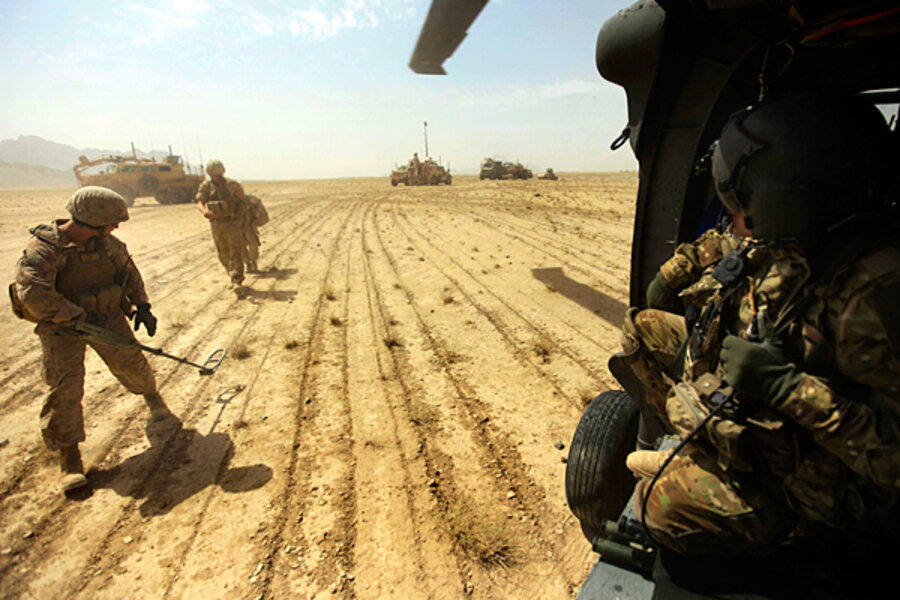Yoohoo! Another investigation turns up taxpayer waste in Afghanistan.
Loading...
Today, the Special Inspector General for Afghanistan Reconstruction (SIGAR) reports that a $47 million US government stability program failed to bring any stability.
Last week, SIGAR reported that millions of dollars given to Afghan contractors to place grates over culverts to prevent explosives being hidden inside of them were misspent, likely leading to the deaths of US and other forces when grates were either not installed or installed improperly. At the end of June, SIGAR reported that the Pentagon was moving forward with a $772 million purchase of aircraft for the Afghan military "even though the Afghans lack the capacity to operate and maintain them."
Last year, SIGAR found that despite a US government program to help Afghanistan end money laundering, billions in drug proceeds and stolen aid money continued to flow out of Kabul International Airport.
And those are just the recent findings from SIGAR that have caught my eye. The government's inspector general, created to monitor the billions of dollars flowing to the Afghan war effort, has been churning out high quality reports for years, and if you read enough of them, the picture that emerges is one of weak monitoring, duplicitous contractors, hundreds of millions spent on facilities the US military won't use, or the Afghans don't want, or can't feasibly use.
The long-term impact of all this?
So far, very little, as far as I can tell. SIGAR issues reports and press releases and make itself available to answer questions from the press. Journalists cover the latest release and then it seems like the story vanishes down the Afghan spending black hole. The amount of money being wasted or directed toward the Taliban and other enemies of the US project rarely comes up in the debates over whether the US should consider a full withdrawal from the country at the end of 2014.
What's the latest?
According to the [Stability in Key Areas Program] contracts, contractors would award grants to communities for projects that address sources of instability identified by the community. In September 2012, USAID and the Afghan government agreed that each of the SIKA programs would be a “quick delivery program,” in which projects identified by the community were initiated quickly but would achieve long-term results. Such projects could include road gravelling, culvert construction, or canal lining. The contracts also state that grants are the “essential” component to the program and shall be provided to communities. Although USAID had disbursed approximately $47 million for the four SIKA contracts as of March 31, 2013, none of the funds had gone to grants that fund community projects, such as those that are “labor-intensive or productive infrastructure projects,” as called for in the SIKA contracts to address sources of instability [emphasis added].
SIGAR places the blame for this on the nine-month delay in an agreement between the United States Agency for International Development (USAID) and the Afghan government to work together. And while money hasn't been set, SIGAR reports that potential Afghan grantees are experiencing "fatigue" from endless rounds of planning workshops that lead nowhere. The program is, in effect, undermining crediblity and support for the US and the Afghan government, so far. "Such disappointment may actually result in further destabilization and disaffection toward the Afghan government," according to the report.
What happened with the $47 million?
SIGAR says that it has been disbursed to two for-profit contractors working with USAID - DAI of Bethesda, Maryland and Los Angeles-based AECOM. SIGAR says that USAID commented on a draft of the report and updated their figures, showing that $285,000 in disbursements had been made to Afghan grantees as of July 1, "only 0.6 percent of the $46.5 million designated for grants," SIGAR writes.
Most of the money spent so far has been on operational expenses for the contractors, research, and about 150 community workshops and training sessions. All of this for what was meant to be a "quick delivery" program designed to get Afghans to work and improve local infrastructure.
Conducting programs in far-off lands with limited infrastructure and with language and cultural barriers at every turn are hard, particularly when there's a war on. There are plenty of understandable reasons for why these sorts of programs don't pan out as advertised. Yet the spending train continues to steam along.
Money is often pointed to as an important weapon for the US war effort in Afghanistan, much as it was in Iraq.
The Commanders Emergency Response Fund (CERP), cash that senior officers were allowed to dole out without prolonged contracting procedures, was used widely in Iraq, and still is in Afghanistan. In the case of CERP in Iraq, SIGAR's counterpart for Iraq spending said in its final report in July that $370 million was supposed to spent equipping and paying the so-called Sons of Iraq, Sunni militias – many former insurgents who switched sides in 2007 and were a major reason that fighting there cooled.
Did the money go where it was intended? Impossible to say, the Special Inspector for Iraq Reconstruction found.
The chance that a large amount of that money was skimmed off the top by Iraqi and other intermediaries in an environment where "monitoring was weak" is probably close to 100 percent. And if money didn't get to its intended recipients – former Sunni insurgents who switched sides at great personal risk – there's a chance that disillusionment among these men partially explains the reinvigorated Sunni insurgency in Iraq.
One wonders if the same problems are plaguing CERP spending in Afghanistan now.








